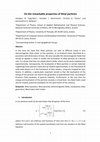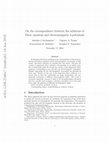Papers by Aristides Kechriniotis

EPL, May 30, 2023
In this work we provide a novel class of degenerate solutions to the Dirac equation for massive p... more In this work we provide a novel class of degenerate solutions to the Dirac equation for massive particles, where the rotation of the spin of the particles is synchronized with the rotation of the magnetic field of the wave-like electromagnetic fields corresponding to these solutions. We show that the state of the particles does not depend on the intensity of the electromagnetic fields, but only on their frequency, which is proportional to the mass of the particles and lies in the region of Gamma/X-rays for typical elementary charged particles, such as electrons and protons. We have also calculated the electric current density corresponding to the electromagnetic 4-potentials connected to the degenerate solutions and found that it has the same spatial and temporal dependence on the electromagnetic fields, rotating at an exceptionally high frequency. This result indicates that the degenerate states may occur at locations where matter collapses, e.g., in the central region of a black hole. Finally, we have calculated the spin of the particles described by degenerate spinors and found that it rotates in synchronization with the magnetic field and the current density.

Annalen der Physik, Oct 6, 2022
In this work we show that Weyl particles can exist at different states in zero electromagnetic fi... more In this work we show that Weyl particles can exist at different states in zero electromagnetic field, either as free particles, or at localized states described by a parameter with dimensions of mass. We also calculate the electromagnetic fields that should be applied in order to modify the localization of Weyl particles at a desired rate. It is shown that they are simple electric fields, which can be easily implemented experimentally. Consequently, the localization of Weyl particles in certain materials supporting these particles could also be studied experimentally, in the framework of solid-state physics or in the framework of laser physics, using ions trapped by laser beams. In addition, a particularly important remark is that the localization of the energy of the particles can lead to the generation of gravitational mass, according to Einstein's field equations of general relativity. Furthermore, in the case that the energy and localization of the particles exceeds a critical level, tiny black holes could also be created, potential candidates for the dark matter of the universe.

arXiv (Cornell University), May 19, 2022
In this work we show that Weyl particles can exist at different states in zero electromagnetic fi... more In this work we show that Weyl particles can exist at different states in zero electromagnetic field, either as free particles, or at localized states described by a parameter with dimensions of mass. We also calculate the electromagnetic fields that should be applied in order to modify the localization of Weyl particles at a desired rate. It is shown that they are simple electric fields, which can be easily implemented experimentally. Consequently, the localization of Weyl particles in certain materials supporting these particles could also be studied experimentally, in the framework of solid-state physics or in the framework of laser physics, using ions trapped by laser beams. In addition, a particularly important remark is that the localization of the energy of the particles can lead to the generation of gravitational mass, according to Einstein's field equations of general relativity. Furthermore, in the case that the energy and localization of the particles exceeds a critical level, tiny black holes could also be created, potential candidates for the dark matter of the universe.

arXiv (Cornell University), Jul 12, 2023
In this work we propose a novel device for controlling the flow of information using Weyl fermion... more In this work we propose a novel device for controlling the flow of information using Weyl fermions. Based on a previous work of our group, we show that it is possible to fully control the flow of Weyl fermions on several different channels, by applying an electric field perpendicular to the direction of motion of the particles on each channel. In this way, we can transmit information as logical bits, depending on the existence or not of a Weyl current on each channel. We also show that the response time of this device is exceptionally low, less than 1 ps, for typical values of its parameters, allowing the control of the flow of information at extremely high rates, of the order of 100 Petabits per second. This device also offers additional advantages, as low power consumption and robustness against electromagnetic perturbations, and is expected to find important applications in several fields, as telecommunications, signal processing, classical and quantum computing, etc. In addition, we demonstrate that Weyl fermions can be efficiently guided through the proposed device using appropriate magnetic fields. Finally, we discuss some particularly interesting remarks regarding the electromagnetic interactions of high energy particles.

arXiv (Cornell University), Jan 4, 2023
In this work, we study the Hermite interpolation on n-dimensional non-equally spaced, rectilinear... more In this work, we study the Hermite interpolation on n-dimensional non-equally spaced, rectilinear grids over a field k of characteristic zero, given the values of the function at each point of the grid and the partial derivatives up to a maximum degree. First, we prove the uniqueness of the interpolating polynomial, and we further obtain a compact closed form that uses a single summation, irrespective of the dimensionality, which is algebraically simpler than the only alternative closed form for the n-dimensional classical Hermite interpolation [1]. We provide the remainder of the interpolation in integral form; we derive the ideal of the interpolation and express the interpolation remainder using only polynomial divisions, in the case of interpolating a polynomial function. Moreover, we prove the continuity of Hermite polynomials defined on adjacent n−dimensional grids, thus establishing spline behavior. Finally, we perform illustrative numerical examples to showcase the applicability and high accuracy of the proposed interpolant, in the simple case of few points, as well as hundreds of points on 3D-grids using a spline-like interpolation, which compares favorably to state-of-the-art spline interpolation methods.
arXiv (Cornell University), Oct 4, 2022
In this work we describe a general method for obtaining degenerate solutions to the Dirac equatio... more In this work we describe a general method for obtaining degenerate solutions to the Dirac equation, corresponding to an infinite number of electromagnetic 4-potentials and fields, which are explicitly calculated. In more detail, using four arbitrary real functions, one can automatically construct a spinor which is solution to the Dirac equation for an infinite number of electromagnetic 4-potentials, defined by those functions. An interesting characteristic of these solutions is that, in the case of Dirac particles with non-zero mass, the degenerate spinors should be localized, both in space and time. Our method is also extended to the cases of massless Dirac and Weyl particles, where the localization of the spinors is no longer required. Finally, we propose two experimental methods for detecting the presence of degenerate states.
Annalen der Physik, Mar 10, 2023
In this work we describe a general method for obtaining degenerate solutions to the Dirac equatio... more In this work we describe a general method for obtaining degenerate solutions to the Dirac equation, corresponding to an infinite number of electromagnetic 4-potentials and fields, which are explicitly calculated. In more detail, using four arbitrary real functions, one can automatically construct a spinor which is solution to the Dirac equation for an infinite number of electromagnetic 4-potentials, defined by those functions. An interesting characteristic of these solutions is that, in the case of Dirac particles with non-zero mass, the degenerate spinors should be localized, both in space and time. Our method is also extended to the cases of massless Dirac and Weyl particles, where the localization of the spinors is no longer required. Finally, we propose two experimental methods for detecting the presence of degenerate states.
Cornell University - arXiv, Sep 22, 2022
In this work we provide a novel class of degenerate solutions to the Dirac equation for massive p... more In this work we provide a novel class of degenerate solutions to the Dirac equation for massive particles, where the rotation of the spin of the particles is synchronized with the rotation of the magnetic field of the wave-like electromagnetic fields corresponding to these solutions. We show that the state of the particles does not depend on the intensity of the electromagnetic fields but only on their frequency, which is proportional to the mass of the particles and lies in the region of Gamma/Xrays for typical elementary charged particles, such as electrons and protons. These novel theoretical results could play an important role in plasma physics, astrophysics, and other fields of physics, involving the interaction of charged particles with high energy photons.
Journal of Inequalities and Applications, 2010
Using a Kurepa's result for Gramians, we achieve refinements of well-known generalizations of Grü... more Using a Kurepa's result for Gramians, we achieve refinements of well-known generalizations of Grüss inequality in inner product spaces. These results are further applied in L 2 a, b to derive improvements of some published trapezoid-Grüss and Ostrowki-Grüss type inequalities. Refinements of the discrete version of Grüss inequality as well as a reverse of the Schwarz inequality are also given.
IEEE Transactions on Signal Processing, 2012
Computers in Biology and Medicine, 2014
Computer Methods and Programs in Biomedicine, 2010
Computer Methods and Programs in Biomedicine, 2013
Using a new mean value Theorem for the remainder in Taylor’s formula, some estimates of differenc... more Using a new mean value Theorem for the remainder in Taylor’s formula, some estimates of difference and sum of two integral means on [a, b], [c,d] with (a, b) ∩ (c,d) = ∅ are obtained. These results are used to obtain complements of two well known generalizations of Ostrowski’s inequality for n-time differentiable functions.

arXiv: Mathematical Physics, 2014
AbstractIn thispaper the inverse problem of the correspondence between the so-lutions of the Dira... more AbstractIn thispaper the inverse problem of the correspondence between the so-lutions of the Dirac equation and the electromagnetic 4-potentials, is fullysolved. The Dirac solutions are classified into two classes. The first oneconsists of degenerate Dirac solutions corresponding to an infinite num-ber of 4-potentials while the second one consists of non-degenerate Diracsolutions corresponding to one and only one electromagnetic 4-potential.Explicit expressions for the electromagnetic 4-potentials are provided inboth cases. Further, in the case of the degenerate Dirac solutions, it isproven that at least two 4-potentials are gauge inequivalent, and con-sequently correspond to different electromagnetic fields. An example isprovided to illustrate this case.PACS: 03.65.Pm, 03.50.De, 41.20.-q 1 Introduction The Dirac equation has been the first electron equation in quantum mechanicsto satisfy the Lorentz covariance [2], initiating the beginning of one of the mostpowerful theories ever formula...
arXiv: Rings and Algebras, 2011
We present a new closed form for the interpolating polynomial of the general univariate Hermite i... more We present a new closed form for the interpolating polynomial of the general univariate Hermite interpolation that requires only calculation of polynomial derivatives, instead of derivatives of rational functions. This result is used to obtain a new simultaneous polynomial division by a common divisor over a perfect field. The above findings are utilized to obtain a closed formula for the semi–simple part of the Jordan decomposition of a matrix. Finally, a number of new identities involving polynomial derivatives are obtained, based on the proposed simultaneous polynomial division. The proposed explicit formula for the semi–simple part has been implemented using the Matlab programming environment.

In a recent work we have shown that all solutions to the Weyl equation and a special class of sol... more In a recent work we have shown that all solutions to the Weyl equation and a special class of solutions to the Dirac equation are degenerate, in the sense that they remain unaltered under the influence of a wide variety of different electromagnetic fields. In the present article our previous work is significantly extended, providing a wide class of degenerate solutions to the Dirac equation for massless particles. The electromagnetic fields corresponding to these solutions are calculated, giving also some examples regarding both spatially constant electromagnetic fields and electromagnetic waves. Further, some general forms of solutions to the Weyl equation are presented and the corresponding electromagnetic fields are calculated. Based on these results, a method for fully controlling the quantum state of Weyl particles through appropriate electromagnetic fields is proposed. Finally, the transition from degenerate to non-degenerate solutions as the particles acquire mass is discussed.

In a recent work we have proven the existence of degenerate solutions to the Dirac equation, corr... more In a recent work we have proven the existence of degenerate solutions to the Dirac equation, corresponding to an infinite number of different electromagnetic fields, providing also some examples regarding massless particles. In the present article our results are extended significantly, providing degenerate solutions to the Dirac equation for particles with arbitrary mass, which, under certain conditions, could be interpreted as pairs of particles (or antiparticles) moving in a potential barrier with energy equal to the height of the barrier and spin opposite to each other. We calculate the electromagnetic fields corresponding to these solutions, providing also some examples regarding both spatially constant electromagnetic fields and electromagnetic waves. Further, we discuss some potential applications of our work, mainly regarding the control of the particles outside the potential barrier, without affecting their state inside the barrier. Finally, we study the effect of small per...









Uploads
Papers by Aristides Kechriniotis